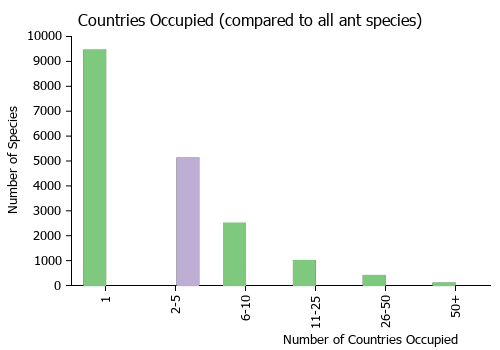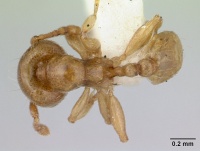Allomerus decemarticulatus
- decemarticulatus. Allomerus decemarticulatus Mayr, 1878: 874 (w.) BRAZIL (Amazonas).
- Type-material: holotype (?) worker.
- [Note: no indication of number of specimens is given.]
- Type-locality: Brazil: “Nord-Brasilien in der Umgegend des Amazonenstromes” (J. Trail).
- Type-depository: NHMW.
- [Misspelled as 10-articulatus by Forel, 1912g: 3; Wheeler, W.M. 1942: 7.]
- Kempf, 1975c: 347 (q.).
- Status as species: Dalla Torre, 1893: 78; Forel, 1895b: 125; Emery, 1922e: 189; Borgmeier, 1927c: 99; Wheeler, W.M. 1942: 198; Ettershank, 1966: 113; Kempf, 1972a: 18; Kempf, 1975c: 347; Brandão, 1991: 324; Bolton, 1995b: 61; Fernández, 2007a: 164 (redescription).
- Distribution: Brazil, French Guiana.
Specimen Label }} Workers of A. decemarticulatus construct a giant trap for capturing insect prey, using spines from the host plant Hirtella physophora and an ascomycete fungus (Dejean et al. 2005, Ruiz-Gonzalez et al. 2011).
Identification
Fernández (2007) - Besides the 10 segmented antennae, this species can be distinguished by its mesosomal shape in lateral view, in which the propodeum forms a weak angle between the faces. The petiolar shape (peduncule longer than the node) and the near lack of sculpture on the mesopleuron and lateral propodeum also makes this species easy to recognize. The anteroventral tooth of the petiole is larger than that of other workers of the genus. Almost the entire body (except for the propodeum) possesses long hairs that are longer than the last antennomere.
Keys including this Species
Distribution
Latitudinal Distribution Pattern
Latitudinal Range: 4.082777778° to -3.10194°.
| North Temperate |
North Subtropical |
Tropical | South Subtropical |
South Temperate |
- Source: AntMaps
Distribution based on Regional Taxon Lists
Neotropical Region: Brazil (type locality), Ecuador, French Guiana.
Distribution based on AntMaps
Distribution based on AntWeb specimens
Check data from AntWeb
Countries Occupied
| Number of countries occupied by this species based on AntWiki Regional Taxon Lists. In general, fewer countries occupied indicates a narrower range, while more countries indicates a more widespread species. |

|
Estimated Abundance
| Relative abundance based on number of AntMaps records per species (this species within the purple bar). Fewer records (to the left) indicates a less abundant/encountered species while more records (to the right) indicates more abundant/encountered species. |

|
Biology
Wheeler (1942) collected A. decemarticulatus on expanded Hirtella peduncles and on Tococa or Duroia, both from Brazil. Colonies of A. decemarticulatus associated with the ant-plant Hirtella physophora (Chrysobalanaceae) are monogynous, with populations of more than 1.000 workers that patrol leaves during the day, searching for prey (Dejean et al. 2001). The Allomerus material reported by Kempf (1975:347) as A. decemarticulatus could be Allomerus brevipilosus, if there is species fidelity to the associated plants.
Dejean et al. (2005) described a tripartite association (insect- plant- fungus) where a communal trap is constructed to ambush prey. The ants cut spines (trichomes) from the ant-plant in which they live (Hirtella physophora), and use them to build a matrix on which an ascomycete mycelium is encouraged to grow. The resulting construction is a platform-like structure with holes having exactly the right diameter to let the ants’ heads and anterior legs pass (Corbara 2005). This elaborate platform functions to trap jumping or flying insects that land on it. These are attacked by the ants from below, cut into pieces and brought back to the domatia.
 Domatia (specialized pouches; left arrow) at the base of leaves of Hirtella physophora. A. decemarticulatus workers capture a green locust thanks to their trap: a gallery made using severed host plant trichomes and the mycelium of an Ascomycete fungus manipulated to create a composite material pierced by numerous holes (from which the workers ambush prey). A wasp landed to rob a piece of the locust abdomen and was also captured, together with the red Reduviid (right arrow). From Dejean et al. 2013 https://doi.org/10.1371/journal.pone.0059405. |
Castes
Nomenclature
- decemarticulatus. Allomerus decemarticulatus Mayr, 1878: 874 (w.) BRAZIL (Amazonas; “Nord-Brasilien in der Umgegend des Amazonenstromes”).
- [Misspelled as 10-articulatus by Forel, 1912g: 3.]
- Kempf, 1975c: 347 (q.).
- Status as species: Dalla Torre, 1893: 78; Forel, 1895b: 125; Emery, 1922e: 189; Borgmeier, 1927c: 99; Wheeler, W.M. 1942: 198; Ettershank, 1966: 113; Kempf, 1972a: 18; Kempf, 1975c: 347; Brandão, 1991: 324; Bolton, 1995b: 61; Fernández, 2007a: 164 (redescription).
Taxonomic Notes
Fernández (2007) - The holotype was not seen. The redescription should be used cautiously because the original description is based on French Guiana queen and worker samples, in which worker possesed 10 segmented antennae. There is a worker from the MZSP (HW 0.50 HL 0.55 SL 0.28 WL 0.50 GL 0.55 TL 2.03 CI 90 SI 56) collected in Brazil (Amazonas, Manaus, Fazenda Esteio, Colosso, mata continua controle, 26 nov to 1 dic 1997, C. Klingenberg col.) with a 10 segmented antennae. This worker is smaller than the one studied from French Guiana and the propodeum is less angulate and does not show the angulation. Unless otherwise noted the text for the remainder of this section is reported from the publication that includes the original description.
Description
Worker
Fernández (2007) - (n=1): HW 0.55 HL 0.58, 0.60 SL 0.33 0.55 WL 0.58 GL 0.54 TL 2.20 CI 94 SI 60.
Antennae 10 segmented, scapes fail to reach posterior lateral corner of head, distal half thickened. Metanotal suture shallow and broad. Propodeum unarmed, dorsal face almost absent followed by declivous face, slightly angulate between faces. Propodeal spiracle small. Petiole with peduncle and with node well defined, node shorter than peduncle. Petiolar anteroventral spine well developed. Sides of mesopleuron and propodeum with few longitudinal short and irregular carinulae. Hairs abundant on dorsum of mesosoma. Long hairs (greater than 0.13 mm in length): six on front of dorsum of head, near vertexal margin and decumbent; two rows of several hairs on frons; several on promesonotum, none on propodeum, several on petiole, postpetiole and gaster. Short hairs (less than 0.07 mm) on all the dorsum of the mesosoma, few are present on propodeum. Row of short hairs present on the anterior clypeal margin, central being the longest, all projecting over anteclypeus. Antennae and legs with apressed pubescence. Concolorous brownish yellow, hairs whitish.
Queen
Fernández (2007) - Head longer than wide, eyes prominent. Antennae 11 segmented without defined club. Scutellum forms slight prominence with convex dorsal part in lateral view. Propodeum angulate between faces. Propodeal spiracle open laterally. Petiolar node shorter than peduncule; peduncule and node broadly joined. Anteroventral process of petiole acute and without tooth or spine. Smooth and polished body. Head with longitudinal striae especially on posterior part. Longitudinal rugulae on posterior part of mesoscutum. Axilar transverse band and scutellum with dense and conspicuous longitudinal striation. Propodeum with limited striation, obliquelly longitudinal below propodeal spiracle. Pilosity abundant on body (length of hairs less than antennal width), except on most of mesoscutum, anepisternum and katepisternum. Concolorous brown with black eyes and axillae.
Karyotype
- 2n = 28, karyotype = 18M+6SM+2A (French Guiana) (Aguiar et al., 2020).
References
- Aguiar, H.J.A.C., Barros, L.A.C., Silveira, L.I., Petitclerc, F., Etienne, S., Orivel, J. 2020. Cytogenetic data for sixteen ant species from North-eastern Amazonia with phylogenetic insights into three subfamilies. Comparative Cytogenetics 14(1): 43–60 (doi:10.3897/CompCytogen.v14i1.46692).
- Albuquerque, E., Prado, L., Andrade-Silva, J., Siqueira, E., Sampaio, K., Alves, D., Brandão, C., Andrade, P., Feitosa, R., Koch, E., Delabie, J., Fernandes, I., Baccaro, F., Souza, J., Almeida, R., Silva, R. 2021. Ants of the State of Pará, Brazil: a historical and comprehensive dataset of a key biodiversity hotspot in the Amazon Basin. Zootaxa 5001, 1–83 (doi:10.11646/zootaxa.5001.1.1).
- Dejean, A., Solano, P. J., Ayroles, J., Corbara, B. & Orivel, J. 2005 Arboreal ants build traps to capture prey. Nature 434: 973. (doi:10.1038/434973a)
- Fernández, F. 2007a. The myrmicine ant genus Allomerus Mayr. Caldasia. 29:159-175.
- Franco, W., Ladino, N., Delabie, J.H.C., Dejean, A., Orivel, J., Fichaux, M., Groc, S., Leponce, M., Feitosa, R.M. 2019. First checklist of the ants (Hymenoptera: Formicidae) of French Guiana. Zootaxa 4674, 509–543 (doi:10.11646/zootaxa.4674.5.2).
- Kempf, W. W. 1975c. Miscellaneous studies on neotropical ants. VI. (Hymenoptera, Formicidae). Stud. Entomol. 18: 341-380 (page 347, queen described)
- Lopes, L.L., Mariano, C.S.F., Delabie, J.H.C., Silva, J.G. 2022. First cytogenetic study through conventional staining of the ant genus Blepharidatta Wheeler, 1915 (Hymenoptera: Formicidae: Attini). Sociobiology 69(4), e7843 (doi:10.13102/sociobiology.v69i4.7843).
- Mayr, G. 1878 [1877]. Formiciden gesammelt in Brasilien von Professor Trail. Verh. K-K. Zool.-Bot. Ges. Wien 27: 867-878 (page 874, worker described)
- Ruiz-Gonzalez M.X., Male, P-J. G., Leroy, C., Dejean, A., Gryta, H., Jargeat, P., Quilichini, A. & Orivel, J. 2011. Specific, non-nutritional association between an ascomycete fungus and Allomerus plant-ants. Biology Letters 7: 475–479.
References based on Global Ant Biodiversity Informatics
- Fernández F. 2007. The myrmicine ant genus Allomerus Mayr (Hymenoptera: Formicidae). Caldasia 29: 159-175.
- Fernández, F. 2007. The myrmicine ant genus Allomerus Mayr (Hymenoptera: Formicidae) Caldasia 29(1): 159-175.
- Franco W., N. Ladino, J. H. C. Delabie, A. Dejean, J. Orivel, M. Fichaux, S. Groc, M. Leponce, and R. M. Feitosa. 2019. First checklist of the ants (Hymenoptera: Formicidae) of French Guiana. Zootaxa 4674(5): 509-543.
- Grangier, J., J. Orivel, M. Negrini and A. Dejean. 2008. Low intraspecific aggressiveness in two obligate plant-ant species. Insectes Sociaux 55(3):238-240.
- Groc S., J. H. C. Delabie, F. Fernandez, M. Leponce, J. Orivel, R. Silvestre, Heraldo L. Vasconcelos, and A. Dejean. 2013. Leaf-litter ant communities (Hymenoptera: Formicidae) in a pristine Guianese rainforest: stable functional structure versus high species turnover. Myrmecological News 19: 43-51.
- Solano P. J., S. Durou, B. Corbara, A. Quilichini, P. Cerdan, M. Belin-Depoux, J. H. C. Delabie, and A. Dejean. Myrmecophytes of the Understory of French GuianianRainforests: Their Distribution and Their Associated Ants. Sociobiology 41(2): 1-10.




